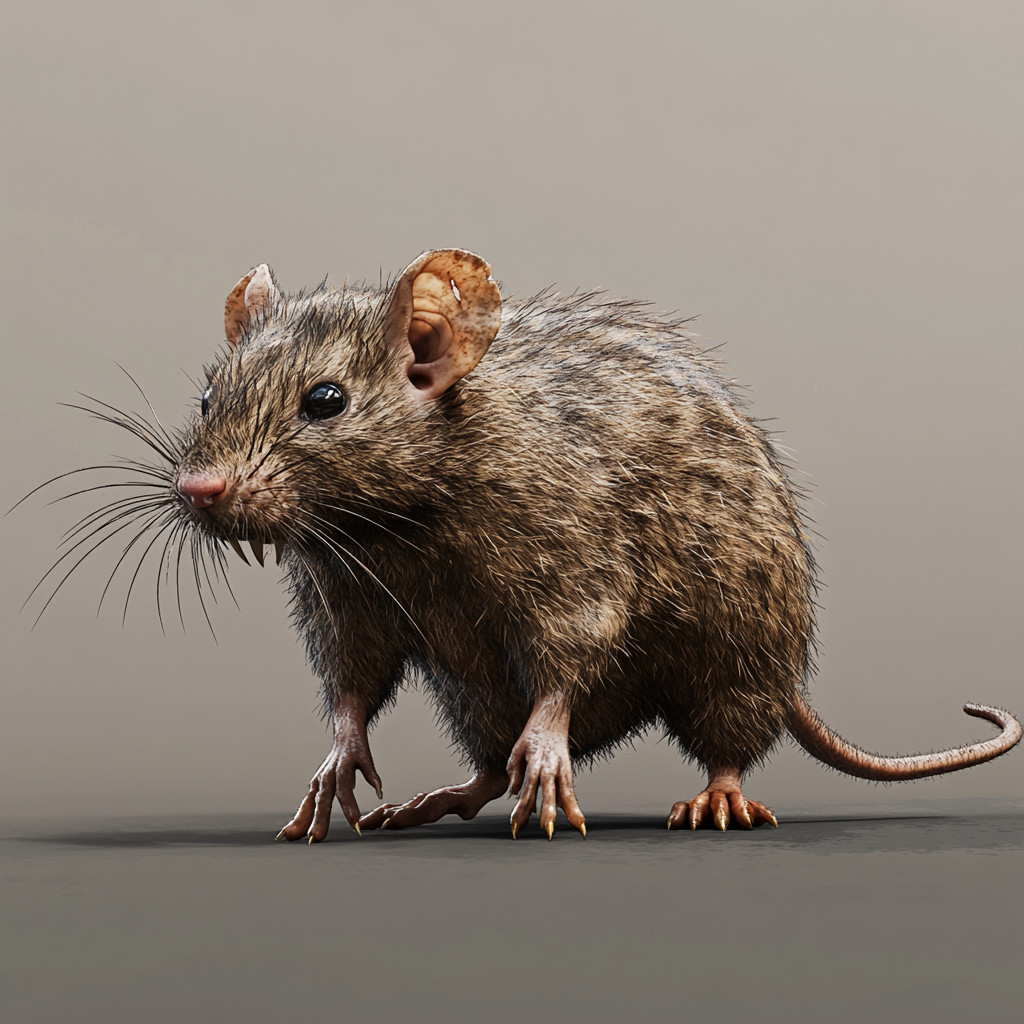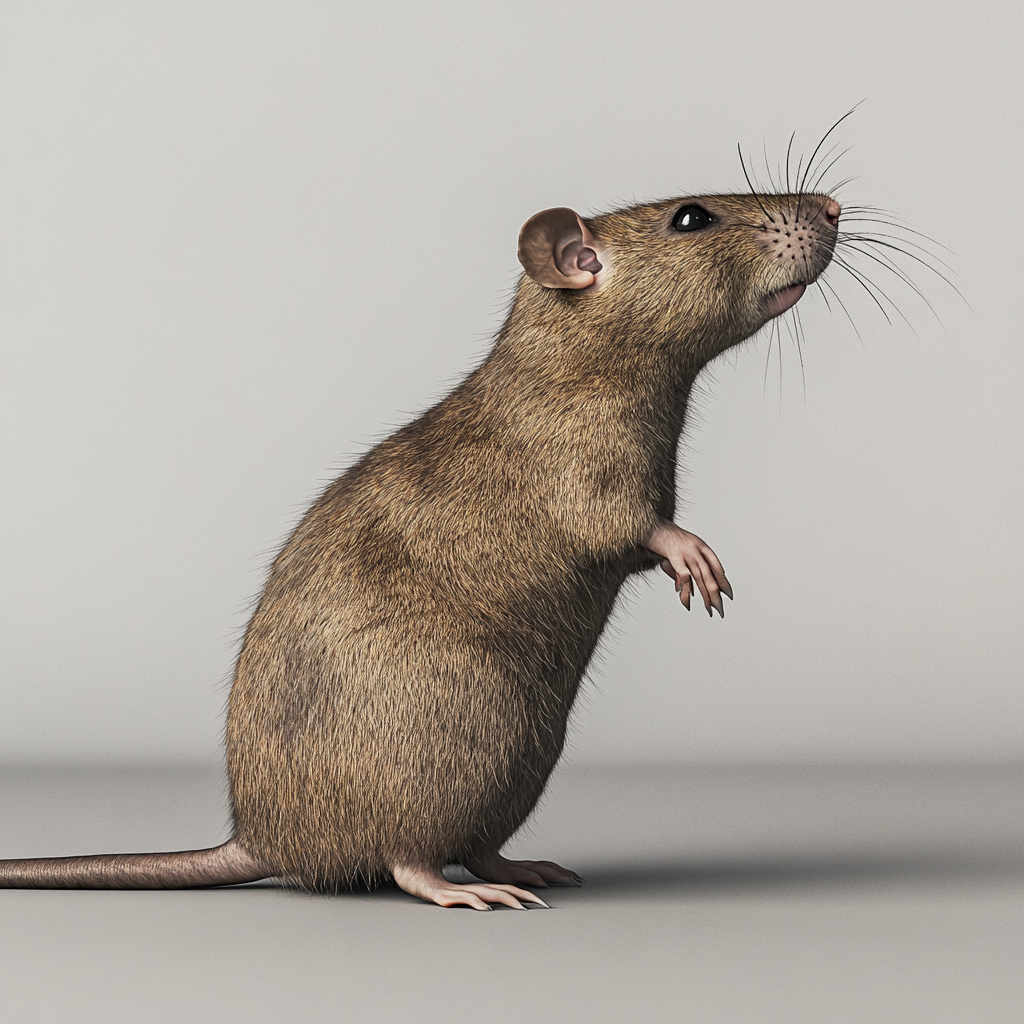Rats



Types of Rats
Norway Rat: Also known as the brown rat or sewer rat, Norway rats are large, with thick, heavy bodies and small ears. They typically measure between 16-20 cm (without the tail), and their fur is coarse and brownish-gray. These rats are commonly found at ground level, preferring to nest in basements, crawl spaces, or burrows in the ground.
Roof Rat: The roof rat, also called the black rat, is smaller and more agile than the Norway rat. They measure around 15-18 cm in body length, with a longer tail and sleek black or dark brown fur. Roof rats are excellent climbers, often found nesting in attics, walls, or upper parts of buildings.
Rat Behavior
Nesting Habits:
- Norway Rats: These rats prefer ground-level nesting and will burrow into the soil to create nests. Indoors, they settle in basements, under decks, or in low-lying structures.
- Roof Rats: Known for their climbing abilities, roof rats nest in high areas such as attics, ceilings, and rafters. They may also nest outdoors in trees or tall shrubs.
Foraging: Rats are omnivores, scavenging for food wherever they can find it. They are most active at night, foraging for food from garbage bins, pet food left out overnight, or stored pantry items. Roof rats often feed on fruits and vegetables, while Norway rats will consume almost anything, including meats, grains, and waste.
Reproduction: Rats reproduce rapidly, with a female rat capable of having up to 7 litters per year, with each litter containing 8-12 young. This means a small population can quickly escalate into a large infestation.
Signs of Infestation
Droppings: Rat droppings are larger than mouse droppings, about 12-20 mm long. Norway rat droppings are blunt at the ends, while roof rat droppings are pointed.
Gnaw Marks: Rats need to constantly chew to keep their teeth sharp. Look for gnaw marks on wood, wiring, or food packaging.
Greasy Tracks: Rats tend to leave greasy smears along walls and floors from the oil on their fur, especially along well-traveled paths.
Burrows: Norway rats will burrow into the ground around foundations, under decks, or in gardens. These burrows are often the size of a small fist.
Scratching Noises: If you hear scratching or scurrying noises at night, particularly in walls or ceilings, it’s a strong indicator of rats, especially roof rats in upper parts of the home.
Dangers/Concerns
Health Risks: Rats are carriers of various diseases that can pose significant health risks to humans:
- Leptospirosis: Transmitted through rat urine, it can cause serious flu-like symptoms.
- Hantavirus: Spread through droppings, urine, or saliva, it can lead to severe respiratory problems.
- Rat-Bite Fever: This disease is transmitted through bites or contact with an infected rat.
Property Damage: Rats are notorious for causing extensive damage to properties:
- Gnawing: Rats gnaw on electrical wires, which can lead to fire hazards. They also chew through insulation, wood, and drywall, weakening structures.
- Contamination: Rats contaminate food and surfaces with their droppings and urine, making any infested area unsanitary.
Prevention Tips
Seal Entry Points: Inspect your home’s exterior for any gaps, cracks, or holes and seal them with steel wool or caulk. Rats can squeeze through surprisingly small openings, especially roof rats.
Proper Waste Disposal: Ensure that all garbage bins are tightly sealed and avoid leaving trash or food waste out overnight.
Eliminate Food Sources: Store food in airtight containers, clean up crumbs and spills immediately, and avoid leaving pet food out for extended periods.
Outdoor Maintenance: Keep bushes, trees, and shrubs trimmed away from the home to prevent roof rats from gaining access. Also, store firewood at least 18 inches off the ground and away from your home.
Treatment Options
DIY Methods:
- Traps: Snap traps, live traps, and glue traps can be effective when placed in areas of high rat activity. Make sure to position traps along walls where rats typically travel.
- Baits: Rat baits and poison can be effective, but caution is necessary around pets and children. Bait stations provide a safer way to administer poisons.
Professional Services: AZ Pest Control specializes in effective rat control strategies, including:
- Inspection and Assessment: We conduct a thorough inspection to locate entry points, nests, and areas of activity.
- Exclusion and Sealing: We seal off entry points to prevent rats from entering your home.
- Baiting and Trapping: We use advanced traps and bait stations to safely and humanely eliminate rats.
- Follow-Up Services: To ensure the infestation is completely eradicated, we offer follow-up visits and ongoing monitoring.
Why Choose AZ Pest Control
At AZ Pest Control, we understand the urgency and risks of rat infestations. Our team uses cutting-edge techniques and humane methods to remove rats from your home or business quickly and effectively. We not only focus on eliminating the current infestation but also on preventing future ones with comprehensive exclusion strategies. With years of experience and a commitment to customer satisfaction, AZ Pest Control is your trusted partner in keeping your property rat-free.
